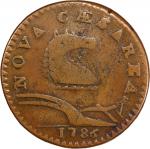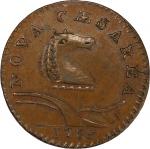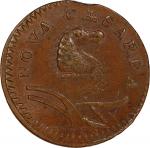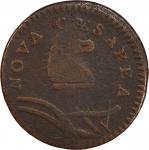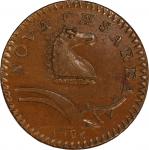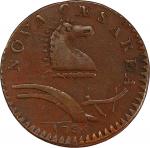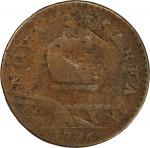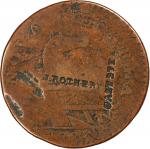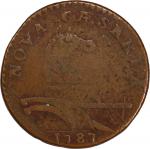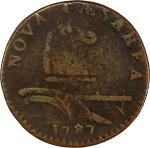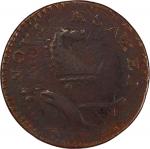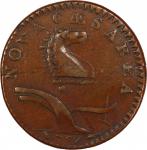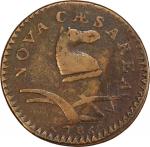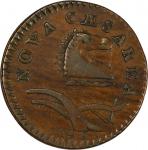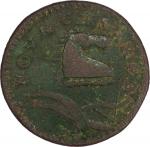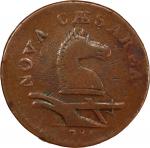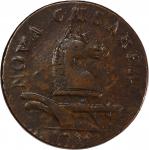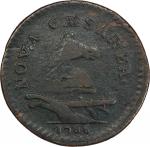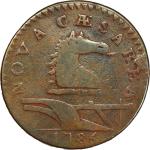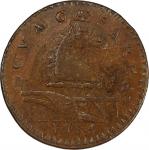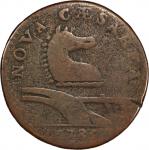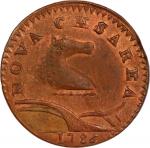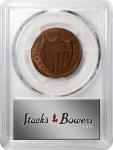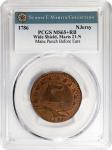1786 New Jersey Copper. Maris 21-N, W-4910. Rarity-3. Wide Shield. MS-65+ RB (PCGS). 157.2 grains. 28.2 mm. New Jersey coppers were not meant to be saved. They were born into fairly grim circumstances: a new nation, having lost its largest trading partner for years on end, in the midst of a post-war depression and chaotic reordering of the economy. The state of New Jersey did not authorize three million coppers to be struck because it wanted to get into the coining business. Instead, commerce demanded it, and there was limited ability to conduct business at the time because of a dearth of circulating medium.<p><p>Siboni, Howes, and Ish posit that the full three million coppers were struck over a span from 1786 into 1790, of which less than 1% - fewer than 30,000 - survive in any grade. Most circulated for decades, trading hand to hand alongside large cents into the 1850s. The coppers we encounter were worn, damaged, and worse. Many were dug out of the ground.<p><p>PCGS has assigned grades to some 2,660 New Jersey coppers over the years (plus some large but unknown number that received details grades). Of those, theyve given exactly two the RB designation. It probably doesnt require even writing that none have been called RD.<p><p>Mint State New Jersey coppers are genuinely rare. There are a handful of varieties that are fairly common in high grades (Maris 21-N isnt one of them), but even the Maris 43-d and Maris 48-g coppers cant be called common in truly Uncirculated condition. All that, of course, is beyond the conversation that yesterdays AU is todays MS-62 BN. There are MS coins, and then there are those that are truly, definitively, uncirculated.<p><p>This is the second finest New Jersey copper PCGS has ever graded. Their finest, the Partrick Maris 48-g, was recently crossed from MS-65 RB (NGC) to MS-66 RB (PCGS). Its an amazing coin, a true prize, and has abundant original mint color. Like this piece, it has a provenance that begins with a single coin find in Europe, discovered by Fred Baldwin and quickly sold to Mrs. Emery Mae Norweb, who cherished it. She acquired it in 1961. It remained in her collection until 1987, when it was acquired by Don Partrick, in whose collection it remained until 2021.<p><p>Syd acquired this coin by sealed bid at the 2010 FUN Convention shortly after its discovery. Many of us saw it at the same time he did and were simply awestruck at its quality and the unlikelihood of its survival in this grade. It was said to have come from France, where Billy Paul had deep connections and great sources. It was raw, and it was available. Syd wanted it the most.<p><p>The coin looks today just as it did then. Its surfaces are barely faded from full mint color, mellowed in the fields, though brown is a misnomer. The lustre is frosty on the obverse, satiny and smooth in the obverse periphery. On the reverse its bolder, with intact cartwheel that lights up the mint color as it passes. There are hints of rose and gold in the orange-tinted mint red, somehow getting prettier with age. The surfaces tell an extraordinary story of this dies preparation, with raised file marks left in the surface of the die around all of CAESAREA, at the tip of the plowbar, between the plowshare and coulter, and under the plow handles. The engraver who created this was professional, careful, and dedicated to this die looking its best. A raised rim (or, as minters sometimes called it, a "fin") is present at the upper right obverse, lifted up by the outside of the die edge beyond the denticles. The alignment towards the lower left means no denticles are visible there, but they nicely frame the rest of that sides circumference. On the reverse, the strike is definitive, and the shield is entirely brought up. Those raised finish lines are visible in almost every field. The strike is aligned to 12:00, creating a particularly bold arc of denticles below the shield. There are no significant marks or spots or mint-made flaws on either side. The dies are perfect, Die State 1. This copper is every bit a gem.<p><p>State coppers with significant mint red are memorable, and every specialist has their favorites. Among New Jerseys, a few stand out: the Taylor Maris 23-R, permanently memorialized on that memorable catalogues cover; the Boyd-Ford Maris 53-j; the Norweb 18-M, that sold in Don Partricks sale last year for $156,000. This piece is in that class. If its not yet legendary, nor were the ones mentioned until they appeared in a numismatic auction catalogue in full color. Now, they each belong to the ages.<p><p>Its unnecessary to state this is the finest known Maris 21-N. Theres another Unc, the Mills-Garrett coin, but this coins position atop the census is safe. Two nice AUs follow, then several EFs. The E Pluribus Unum Collection coin, graded EF-45+ (PCGS), will undoubtedly be a new addition to the census when the next edition of the Siboni-Howes-Ish book appears. This coin is depicted in brilliant color on p. 245 of the current edition with a simple caption: Maris 21-N (Martin). This may always be the Martin coin. At this moment in time, hes the only collector whose name we know who has ever owned it. Whoever the European visitor to New Jersey was who first plucked it out of circulation as a curiosity and took it home has done us a favor. Theyve given us a real insight into what New Jersey coppers looked like when they were brand new. This coin may be about as close as we ever get. PCGS# 902870. From the Sydney F. Martin Collection. Earlier from France via American Heritage Minting (William Paul), January 2010.

